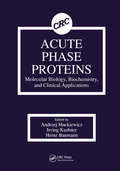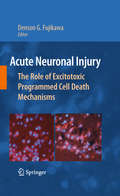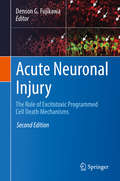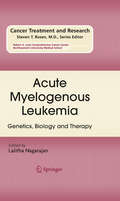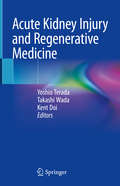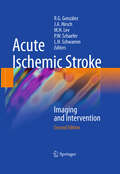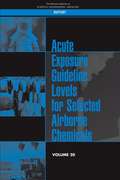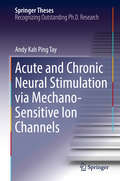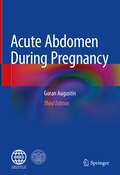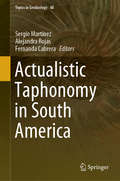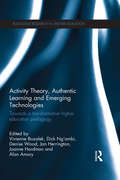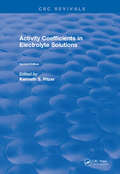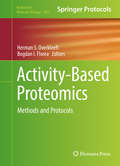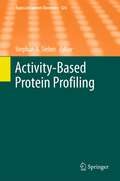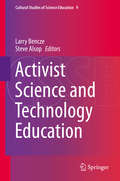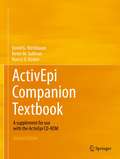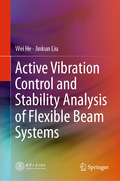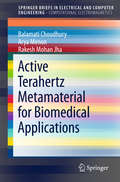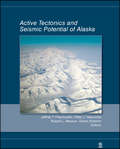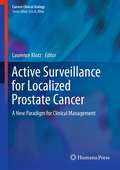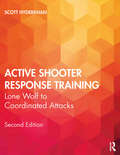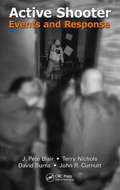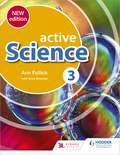- Table View
- List View
Acute Phase Proteins Molecular Biology, Biochemistry, and Clinical Applications
by Irving Kushner Andrzej Mackiewicz Heinz BaumannAcute Phase Proteins covers all major aspects of acute phase proteins (APP) starting with molecular mechanisms regulating their synthesis and ending with their functional significance. The book features 36 chapters addressing such topics as acute phase response and the APP; major APP and their structure and functions; regulation of APP synthesis, the cytokines and hormones implicated in these processes, and molecular mechanisms involved; signal transduction of cytokines in hepatocytes and posttranscriptional processes; and quantitative and qualitative evaluation of APP in clinical practice. The book will be an important reference for immunologists, molecular biologists, cellular biologists, biochemists, and clinical chemists.
Acute Neuronal Injury: The Role of Excitotoxic Programmed Cell Death Mechanisms
by Denson G. FujikawaThe purpose of this book is to present clinically relevant basic mechanisms of excitotoxic neuronal death, which in the adult mammalian brain is morphologically necrotic, not apoptotic, and which involve caspase-independent mechanisms of programmed cell death. The spectrum of clinically relevant pathologically induced excitotoxic neuronal death includes cerebral ischemia, traumatic brain injury, cerebral hypoglycemia, and status epilepticus. By investigating mechanisms, potential neuroprotective strategies can be identified that may have future clinical application.
Acute Neuronal Injury: The Role of Excitotoxic Programmed Cell Death Mechanisms
by Denson G. FujikawaAn overview of the biochemical mechanisms that produce acute nerve cell death in the brain. Covers injuries and disorders including stroke, brain and spinal cord trauma, hypoglycemic coma, and prolonged epileptic seizures. All of these lead to high concentrations of calcium in nerve cells which, in turn, causes degradation of cytoplasmic proteins, cleavage of nuclear DNA, and eventually cell death. The Second Edition contains 11 thoroughly updated chapters and 3 additional chapters that did not appear in the previous edition.
Acute Myelogenous Leukemia: Genetics, Biology and Therapy (Cancer Treatment and Research #145)
by Lalitha NagarajanAcute myelogenous leukemia (AML), is the most common form of leukemia in adults. AML is a deadly form of malignancy, the prognosis for which has not improved in the last two decades. More importantly, it is a malignancy that is seen in older adults, therefore the number of cases is likely to rise as the population ages. Over the past 15 years, genetic mechanisms underlying AML have begun to unfold. Additional research in this area has helped identify key components and characteristics. Consequently, targeted therapy of AML is receiving much attention. It is the hope of researchers that as with chronic myelogenous leukemia (CML), and the drug, Gleevec, a targeted therapy for AML will be discovered.
Acute Kidney Injury and Regenerative Medicine
by Yoshio Terada Takashi Wada Kent DoiThis book presents up-to-date information on the clinical-pathophysiological features of acute renal injury and discusses the KDIGO diagnostic criteria, as well as novel experimental findings, including in the area of regenerative medicine. It also highlights the clinical-pathophysiological importance of AKI in clinical settings, including differential diagnoses and management of AKI. In the past, the pathology associated with sudden renal impairment was characterized as acute renal failure (ARF). However, in the 2000s, the joint efforts of specialists in fields including nephrology, intensive care medicine, and cardiovascular medicine led to the introduction of a novel concept known as acute kidney injury (AKI). As medical care progressed, patients such as high-risk elderly subjects who were not deemed to be candidates for invasive therapy came to be treated in intensive care units (ICUs). As a result, kidney injury as a subset of multiple organ failure was re-considered as AKI, especially in intensive care medicine. AKI was then proposed as a novel disease concept to emphasize the importance of early diagnosis and early intervention to improve prognosis.Presenting novel features, such as the definition of AKI, risk factors and management; biomarkers, such as neutrophil gelatinase-associated lipocalin (NGAL) and L-type fatty acid-binding protein (L-FABP); long-term outcomes of AKI; as well as renal regeneration using iPS cell, manipulation of embryonic genes, and Xenotransplanted embryonic kidney, this book is of interest to all physicians and researchers in this field around the globe.
Acute Ischemic Stroke: Imaging and Intervention
by Joshua A. Hirsch Lee H. Schwamm Michael H. Lev Pamela W. Schaefer R. Gilberto GonzálezThis updated second edition of Acute Ischemic Stroke: Imaging and Intervention provides a comprehensive account of the state of the art in the diagnosis and treatment of acute ischemic stroke. The basic format of the first edition has been retained, with sections on fundamentals such as pathophysiology and causes, imaging techniques and interventions. However, each chapter has been revised to reflect the important recent progress in advanced neuroimaging and the use of interventional tools. In addition, a new chapter is included on the classification instruments for ischemic stroke and their use in predicting outcomes and therapeutic triage. All of the authors are internationally recognized experts and members of the interdisciplinary stroke team at the Massachusetts General Hospital and Harvard Medical School. The text is supported by numerous informative illustrations, and ease of reference is ensured through the inclusion of suitable tables. This book will serve as a unique source of up-to-date information for neurologists, emergency physicians, radiologists and other health care providers who care for the patient with acute ischemic stroke.
Acute Exposure Guideline Levels for Selected Airborne Chemicals: Volume 20
by National Academies of Sciences Engineering MedicineExtremely hazardous substances can be released accidentally as a result of chemical spills, industrial explosions, fires, or accidents involving railroad cars and trucks transporting EHSs. Workers and residents in communities surrounding industrial facilities where these substances are manufactured, used, or stored and in communities along the nation’s railways and highways are potentially at risk of being exposed to airborne EHSs during accidental releases or intentional releases by terrorists. Pursuant to the Superfund Amendments and Reauthorization Act of 1986, the U.S. Environmental Protection Agency (EPA) has identified approximately 400 EHSs on the basis of acute lethality data in rodents. Acute Exposure Guideline Levels for Selected Airborne Chemicals, Volume 20 reviews and updates the technical support document on acute exposure guideline levels (AEGLs) for selected chloroformates. This update focuses on establishing AEGL-3 values for n-propyl chloroformate and isopropyl chloroformate, but will also consider whether any new data are available that would affect the proposed values for the other 10 chloroformates. AEGLs represent threshold exposure limits (exposure levels below which adverse health effects are not likely to occur) for the general public and are applicable to emergency exposures ranging from 10 minutes (min) to 8 h. Three levels - AEGL-1, AEGL-2, and AEGL-3 - are developed for each of five exposure periods (10 min, 30 min, 1 h, 4 h, and 8 h) and are distinguished by varying degrees of severity of toxic effects. This report will inform planning, response, and prevention in the community, the workplace, transportation, the military, and the remediation of Superfund sites.
Acute Exposure Guideline Levels for Selected Airborne Chemicals: VOLUME 1
by National Research CouncilIn the Bhopal disaster of 1984, approximately 2,000 residents living near a chemical plant were killed and 20,000 more suffered irreversible damage to their eyes and lungs following the accidental release of methyl isocyanate. This tragedy served to focus international attention on the need for governments to identify hazardous substances and assist local communities in planning how to deal with emergency exposures. Since 1986, the U.S. Environmental Protection Agency has been tasked with identifying extremely hazardous substances and, in cooperation with the Federal Emergency Management Agency and the Department of Transportation, assist local emergency response planners. The National Advisory Committee on Acute Exposure Guideline Levels for Hazardous Substances was established in 1995 to develop acute exposure guideline levels (AEGLs) for high priority toxic chemicals that could be released into the air from accidents at chemical plants, storage sites, or during transportation. This book reviews toxicity documents on five chemicals--chlorine, hydrogen chloride, hydrogen fluoride, toluene, and uranium hexafluoride--for their scientific validity, comprehensives, internal consistency, and conformance to the 1993 guidelines report.
Acute and Chronic Neural Stimulation via Mechano-Sensitive Ion Channels (Springer Theses)
by Andy Kah Ping TayThis book describes the tools, developed by the author, for perturbing endogenous mechano-sensitive ion channels for magneto-mechanical neuro-modulation. He explores the ways in which these tools compare against existing ones such as electricity, chemicals, optogenetics, and techniques like thermos/magneto-genetics. The author also reports on two platforms--magnetic ratcheting and magnetic microfluidics for directed evolution and high throughput culture of magnetotactic bacteria--that produce high quality magnetic nanoparticles for biomedical applications like neural stimulations. This thesis was submitted to and approved by the University of California, Los Angeles.
Acute Abdomen During Pregnancy
by Goran AugustinThis is the third edition of a well-received book that reflects the state of the art in the diagnosis and treatment of acute abdominal disorders in pregnant patients, ranging from very rare to more common ones, such as acute appendicitis and acute cholecystitis. The book emphasizes the importance of rapid diagnosis to avoid serious consequences for both the mother and the fetus. The new edition updates recommendations, guidelines, and scenarios to provide support for all clinicians who may encounter such cases. The book includes new chapters, one of which is about non-operative management of acute appendicitis in pregnancy, an important topic that has not been addressed in previous books. The 2nd edition chapter on urologic emergencies has been divided into three, and the book now has 29 chapters in total, which have been significantly updated and reorganized. It provides guidance on different imaging modalities of rare pathologies that can occur during pregnancy, helping clinicians and radiologists to define underlying cases better. The book also includes significantly more colored and black & white images and tables. This new edition is an essential resource for clinicians who care for pregnant patients with acute abdominal disorders. The volume is equally valuable for general and abdominal surgeons, gynecologists and obstetricians, and emergency physicians who may be the first specialists to have clinical contact with pregnant patients.
Actualistic Taphonomy in South America (Topics in Geobiology #48)
by Sergio Martínez Alejandra Rojas Fernanda CabreraHighlighting the latest research on Actualistic Taphonomy (AT), this book presents the outcomes of a meeting that took place in Montevideo, Uruguay, in October 2017. Its respective chapters offer valuable insights into South American archaeology, invertebrate and vertebrate fauna, and flora. In recent years, there has been a surge of new research on AT, as evidenced by numerous papers, talks, theses, etc. However, there are still very few AT books or even dedicated journal articles. Reflecting the discipline’s newfound maturity, this book, written by South American authors, offers a unique resource for academics and students of Paleontology, Geology, and Biology around the world.
Activity Theory, Authentic Learning and Emerging Technologies: Towards a transformative higher education pedagogy (Routledge Research in Higher Education)
by Denise Wood Vivienne Bozalek Dick Ng’ambi Jan Herrington Joanne Hardman Alan AmoryAlthough emerging technologies are becoming popularised for teaching, learning and research, the relationship between their use and transformative effects on higher education remain largely unexplored. This edited collection seeks to fill this gap by providing a nuanced view, locating higher education pedagogical practices at an intersection of emerging technologies, authentic learning and activity systems. Providing numerous case studies as examples, the book draws from a wide range of contexts to illustrate how such a convergence has the potential to track transformative teaching and learning practices in the higher education sector. Chapters provide the reader with a variety of transformative higher education pedagogical practices in southern contexts, theorised within the framework of Cultural Historical Activity Theory (CHAT) and tool mediation, while using authentic learning as a pedagogical model upon which this theoretical framework is based. The topics covered in the book have global relevance, with research paying particular attention to South Africa, Australia and New Zealand, where the authors are based. The book will be of interest to educators, researchers and practitioners in higher education, as well as those interested in emerging technologies in education more generally.
Activity Coefficients in Electrolyte Solutions
by Kenneth S. PitzerThis book was first published in 1991. It considers the concepts and theories relating to mostly aqueous systems of activity coefficients.
Activity-Based Proteomics: 9781493964376 (Methods in Molecular Biology #1491)
by Herman S. Overkleeft Bogdan I. FloreaThis volume focuses on explorative activity-based proteomics, biomedical applications of activity-based proteomics, and chemical strategies in activity-based proteomics providing a concise overview of activity-based protein profiling. Written in the highly successful Methods in Molecular Biology series format, chapters include introductions to their respective topics, lists of the necessary materials and reagents, step-by-step, readily reproducible laboratory protocols, and tips on troubleshooting and avoiding known pitfalls.
Activity-Based Protein Profiling (Topics in Current Chemistry #324)
by Stephan A. SieberABPP Methodology: Introduction and Overview, by Matthew B. Nodwell und Stephan A. Sieber Activity-Based Protein Profiling for Natural Product Target Discovery, by Joanna Krysiak und Rolf Breinbauer Photoaffinity Labeling in Activity-Based Protein Profiling, by Paul P. Geurink, Laurette M. Prely, Gijs A. van der Marel, Rainer Bischoff und Herman S. Overkleeft Application of Activity-Based Protein Profiling to the Study of Microbial Pathogenesis, by William P. Heal und Edward W. Tate Functional Analysis of Protein Targets by Metabolomic Approaches, by Yun-Gon Kim und Alan Saghatelian
Activist Science and Technology Education (Cultural Studies of Science Education #9)
by Larry Bencze Steve AlsopThis collection examines issues of agency, power, politics and identity as they relate to science and technology and education, within contemporary settings. Social, economic and ecological critique and reform are examined by numerous contributing authors, from a range of international contexts. These chapters examine pressing pedagogical questions within socio-scientific contexts, including petroleum economies, food justice, health, environmentalism, climate change, social media and biotechnologies. Readers will discover far reaching inquiries into activism as an open question for science and technology education, citizenship and democracy. The authors call on the work of prominent scholars throughout the ages, including Bourdieu, Foucault, Giroux, Jasanoff, Kierkegaard, Marx, Nietzsche, Rancière and Žižek. The application of critical theoretical scholarship to mainstream practices in science and technology education distinguishes this book, and this deep, theoretical treatment is complemented by many grounded, more pragmatic exemplars of activist pedagogies. Practical examples are set within the public sphere, within selected new social movements, and also within more formal institutional settings, including elementary and secondary schools, and higher education. These assembled discussions provide a basis for a more radically reflexive reworking of science and technology education. Educational policy makers, science education scholars, and science and technology educators, amongst others, will find this work thought-provoking, instructive and informative.
ActivEpi Companion Textbook: A supplement for use with the ActivEpi CD-ROM
by David G. Kleinbaum Kevin M. Sullivan Nancy D. BarkerThis Companion Textbook supplements the ActivEpi CD-ROM, sold separately. The ActivEpi CD-ROM provides a multimedia presentation of concepts, commonly taught in an introductory epidemiology course. ActivEpi mixes a full array of media to motivate, explain, visualize and apply epidemiological concepts. Virtually all of the material on the ActivEpi CD-ROM is included in the Companion Textbook. Because individuals differ in their learning skills, the ActivEpi CD-ROM and the ActivEpi Companion Textbook offer readers different but related options on how to learn epidemiology. The Textbook can be used as a hardcopy reference of the textual materials contained on the CD-ROM, as a resource for the practice exercises, as a general reference, or even a self-contained textbook. ActivEpi includes 15 lessons and over 50 hours of content via more than 250 launchable activities and homework exercises. It can be used in a variety of teaching formats: distance learning, self-paced learning, on-campus courses, and short courses. For the latest additions to ActivEpi, visit David Kleinbaum's website.
Active Vibration Control and Stability Analysis of Flexible Beam Systems
by Wei He Jinkun LiuThis book presents theoretical explorations of several fundamental problems in the dynamics and control of flexible beam systems. By integrating fresh concepts and results to form a systematic approach to control, it establishes a basic theoretical framework. It includes typical control design examples verified using MATLAB simulation, which in turn illustrate the successful practical applications of active vibration control theory for flexible beam systems. The book is primarily intended for researchers and engineers in the control system and mechanical engineering community, offering them a unique resource.
Active Terahertz Metamaterial for Biomedical Applications (SpringerBriefs in Electrical and Computer Engineering)
by Rakesh Mohan Jha Balamati Choudhury Arya MenonThis book describes a metamaterial-based active absorber for potential biomedical engineering applications. Terahertz (THz) spectroscopy is an important tool for imaging in the field of biomedical engineering, due to the non-invasive, non-ionizing nature of terahertz radiation coupled with its propagation characteristics in water, which allows the operator to obtain high-contrast images of skin cancers, burns, etc. without detrimental effects. In order to tap this huge potential, it is important to build highly efficient biomedical imaging systems by introducing terahertz absorbers into biomedical detectors. The biggest challenge faced in the fulfilment of this objective is the lack of naturally occurring dielectrics, which is overcome with the use of artificially engineered resonant materials, viz. metamaterials. This book describes such a metamaterial-based active absorber. The design has been optimized using particle swarm optimization (PSO), eventually resulting in an ultra-thin active terahertz absorber. The absorber shows near unity absorption for a tuning range of terahertz (THz) application.
Active Tectonics and Seismic Potential of Alaska
by Göran Ekström Robert L. Wesson Peter J. Haeussler Jeffrey T. FreymuellerPublished by the American Geophysical Union as part of the Geophysical Monograph Series, Volume 179. This multidisciplinary monograph provides the first modern integrative summary focused on the most spectacular active tectonic systems in North America. Encompassing seismology, tectonics, geology, and geodesy, it includes papers that summarize the state of knowledge, including background material for those unfamiliar with the region; address global hypotheses using data from Alaska; and test important global hypotheses using data from this region. It is organized around four major themes: subduction and great earthquakes at the Aleutian Arc, the transition from strike slip to accretion and subduction of the Yakutat microplate, the Denali fault and related structures and their role in accommodating permanent deformation of the overriding plate, and regional integration and large-scale models and the use of data from Alaska to address important global questions and hypotheses. The book's publication near the beginning of the National Science Foundation's EarthScope project makes it especially timely because Alaska is perhaps the least understood area within the EarthScope footprint, and interest in the region can be expected to rise with time as more EarthScope data become available.
Active Surveillance for Localized Prostate Cancer: A New Paradigm for Clinical Management (Current Clinical Urology)
by Laurence KlotzActive Surveillance for Localized Prostate Cancer: A New Paradigm for Clinical Management will serve as a useful resource for physicians dealing with, and interested in, this complex and evolving branch of prostate cancer management. The book will also be of interest to scientifically literate patients and their families. The volume provides an introduction to the concept of active surveillance in oncology in general and prostate cancer specifically. The primary focus is to provide a comprehensive guide to the management of patients on surveillance. The volume covers the many complexities and nuances to this approach including, patient selection, risk assessment, how to overcome 'cancer hysteria' when counseling patients, identifying appropriate triggers for intervention, use of PSA kinetics and MR imaging information, technique and frequency of biopsies, secondary prevention interventions, and the relative roles of surveillance and focal therapy.
Active Shooter Response Training: Lone Wolf to Coordinated Attacks
by Scott HyderkhanActive Shooter Response Training: Lone Wolf to Coordinated Attack, Second Edition, provides expanded and updated training for police and security officers who must respond to an active shooter situation. This manual addresses all facets of preparation and response, from complex logistical organization to collective and individual tactics, as well as special units or special skills tasks. Based on time-tested military training doctrine, the program described here offers a template for agencies of all sizes to offer training that effectively utilizes officers’ available time. Hyderkhan and his expert contributors cover all aspects of the active shooter response (ASR) mission, from risk analysis to logistical planning for mass casualty events. He also addresses medical care and evacuation, reunification procedures, and post-incident investigation. Active Shooter Response Training, Second Edition, provides the tools needed to prevent or mitigate tragedy in our religious congregations, schools, and public places. The book includes a voucher code for a 50% discount off of the companion online library of training videos This book is directed to law enforcement agencies, private security teams, training organizations, police leaders, and individual officers and trainers, in the US and globally. It also has potential as recommended reading in policing courses at the community college and university level.
Active Shooter Events and Response
by John P. Blair Terry Nichols David Burns John R. CurnuttThe Columbine tragedy on April 20, 1999 began a new era in law enforcement as it became apparent that the police response to such mass shootings must be drastically altered. By the time the Sandy Hook Elementary School shooting occurred on December 14, 2012, outdated police response strategies had been replaced with new, aggressive tactics used by
Active Science 3 new edition
by Ann FullickBuild and assess your students' Science knowledge, understanding and skills through better learning techniques, ensuring a solid foundation for further science study.- Confidently meet the requirements of the Trinidad & Tobago, Barbados, Guyana and OECS curricula and CXC's CCSLC syllabus with detailed mapping grids available for free online. - Inspire students to progress with this contemporary take on Science that includes topics such as environmental science and green issues.- Engage students through an active learning approach with hands-on activities to promote learning through practice.- Prepare students for moving up to CSEC® level science with activities developed to bridge the gap between lower secondary and CSEC® level.
Active Science 3 new edition (Active Science #3)
by Ann FullickBuild and assess your students' Science knowledge, understanding and skills through better learning techniques, ensuring a solid foundation for further science study.- Confidently meet the requirements of the Trinidad & Tobago, Barbados, Guyana and OECS curricula and CXC's CCSLC syllabus with detailed mapping grids available for free online. - Inspire students to progress with this contemporary take on Science that includes topics such as environmental science and green issues.- Engage students through an active learning approach with hands-on activities to promote learning through practice.- Prepare students for moving up to CSEC® level science with activities developed to bridge the gap between lower secondary and CSEC® level.
